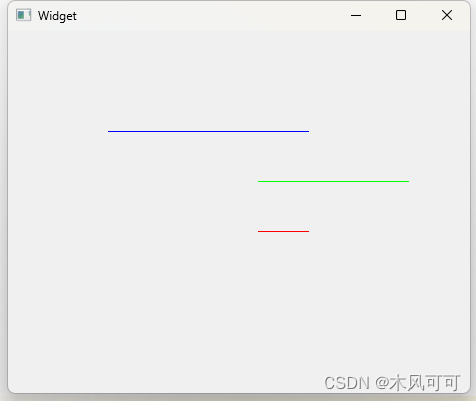QLineF intersection; bool isSuccess = GetOverlapSegment ( line1, line2, intersection) ;
bool DoLineOverlapWithSameSlope ( const QLineF& line1, const QLineF& line2)
{ qreal slope1 = line1. dy ( ) / line1. dx ( ) ; qreal slope2 = line2. dy ( ) / line2. dx ( ) ; qreal epsilon = 1e-6 ; if ( std:: abs ( slope1 - slope2) > epsilon) { return false ; } qreal b1 = line1. p1 ( ) . y ( ) - slope1 * line1. p1 ( ) . x ( ) ; qreal b2 = line2. p1 ( ) . y ( ) - slope1 * line2. p1 ( ) . x ( ) ; qreal x_overlap = ( b2 - b1) / ( slope1 - slope2) ; if ( x_overlap < qMin ( line1. p1 ( ) . x ( ) , line1. p2 ( ) . x ( ) ) || x_overlap > qMax ( line1. p1 ( ) . x ( ) , line1. p2 ( ) . x ( ) ) || x_overlap < qMin ( line2. p1 ( ) . x ( ) , line2. p2 ( ) . x ( ) ) || x_overlap > qMax ( line2. p1 ( ) . x ( ) , line2. p2 ( ) . x ( ) ) ) { return false ; } return true ;
} bool GetOverlapSegment ( const QLineF& line1, const QLineF& line2, QLineF& overlap)
{ bool is_overlap = DoLineOverlapWithSameSlope ( line1, line2) ; if ( ! is_overlap) return false ; qreal start1 = qMin ( line1. p1 ( ) . x ( ) , line1. p2 ( ) . x ( ) ) ; qreal end1 = qMax ( line1. p1 ( ) . x ( ) , line1. p2 ( ) . x ( ) ) ; qreal start2 = qMin ( line2. p1 ( ) . x ( ) , line2. p2 ( ) . x ( ) ) ; qreal end2 = qMax ( line2. p1 ( ) . x ( ) , line2. p2 ( ) . x ( ) ) ; qreal overlapStart = qMax ( start1, start2) ; qreal overlapEnd = qMin ( end1, end2) ; if ( overlapStart <= overlapEnd) { qreal minY1 = qMin ( line1. p1 ( ) . y ( ) , line1. p2 ( ) . y ( ) ) ; qreal maxY1 = qMax ( line1. p1 ( ) . y ( ) , line1. p2 ( ) . y ( ) ) ; qreal minY2 = qMin ( line2. p1 ( ) . y ( ) , line2. p2 ( ) . y ( ) ) ; qreal maxY2 = qMax ( line2. p1 ( ) . y ( ) , line2. p2 ( ) . y ( ) ) ; qreal overlapMinY = qMax ( minY1, minY2) ; qreal overlapMaxY = qMin ( maxY1, maxY2) ; overlap. setP1 ( QPointF ( overlapStart, overlapMinY) ) ; overlap. setP2 ( QPointF ( overlapEnd, overlapMaxY) ) ; return true ; } return false ;
}






)











挑战题)

)